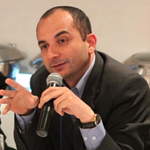Camilo Cetina
Paola Constatín

Since May 2022, the Vortex Foundation and CAF—development bank of Latin America—have made a digital tool available to citizens that has the potential to change the way we understand corruption, in an ambitious cooperation project with Colombia’s Transparency Secretariat. The project consisted of developing, launching and opening to the public the new Networks module in the Colombia Anti-Corruption website (PACO), where large amounts of data were collected and analyzed with the aim of identifying possible corruption networks that often go unnoticed due to their nature.
Corruption in Colombia cannot be studied based on isolated cases, since it generally operates through networks, or connections between various players, within or outside the state, public or private, legal or illegal, while influencing institutions and favoring particular interests to the detriment of the general interest. Not all agents participating in these networks have the same power or play the same roles, but the systematic character and coordination make criminal activities grow and reproduce, even reaching stages where the government or its agencies may be co-opted by interest groups with a criminal intent (Garay, Salcedo-Albarán, León-Beltrán and Guerrero, 2008).
Using this conceptual approach, CAF provided technical assistance to the Presidency of Colombia’s Transparency Secretariat to develop a data platform related to corruption available to the state. This is how a system was created to identify criminal niches and issue early warnings for authorities and citizens through data intelligence, specifically network analysis.
Thus, PACO was converted into a platform that centralizes information in three basic categories: first, the corruption situation in Colombia, based on international indicators; second, the systematic operation of corruption networks, based on judicial documents and information extracted from the media, and third, the main corruption risks in the nation, identifying inconsistencies in public procurement processes.
This initiative’s objective is to allow the state to use of a great deal of information that would otherwise remain disconnected, due to deficiencies in the digital infrastructure. The capacity for collection, organization and analysis derived from this project allows mapping the connections between several agents, showing characteristics, determining risks, and identifying corruption networks set up around certain sectors, such as healthcare management or public procurement.
This tool is based on the premise that it is not enough to observe isolated cases in order to identify how corruption operates. It is necessary to understand how these phenomena interconnect with each other through nodes, such as individuals, companies or criminal groups, which are related through flows of money, favors or information, for example. This makes it possible to map how these flows originate and persons of interest, identify “hubs” or hyperconnected nodes and start unveiling complex criminal structures, which would be impossible working with pen and paper alone.
The first phase of the project consisted of identifying the data available to the Secretariat and compiling previously unavailable data from other government agencies, and then filtering, optimizing and organizing the information in PACO. The second phase focused on developing and implementing algorithms to create indicators, alerts and graphs that would expose corruption in Colombia for comparisons—internationally —; internally—as a national, regional and local issue—; and from a systemic approach—as corruption networks-.
The last phase aimed to finalize the project and ensure sustainability, based on the production and publication of a protocol, and training Secretariat officials on the use, maintenance and expansion of the system. The Secretariat will therefore continue to input and analyze the databases, looking for continuity in the use of this tool to prevent and combat corruption.
The path to digital transformation of the state involves overcoming challenges, ranging from the construction of a new and solid data infrastructure, to the implementation of AI and network analysis tools that make predictions and identify trends, characteristics and links in illicit activities. Advancing along this path is an increasingly vital task, due to its potential in building a transparent, accountable state, open to interaction with citizens and effective in the fight against corruption.
Today, in commemoration of the International Day for Universal Access to Information, CAF invites interested parties to visit PACO, explore its module redes and learn first-hand about digital innovations that pay dividends in terms of public integrity.













